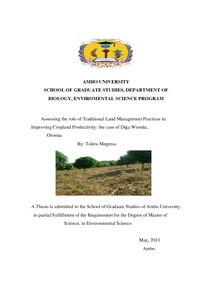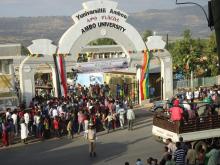Resource information
A Land management practice has many forms and the focus of this research is on
traditional land management practices. The main objective of this study was to assess the
role of traditional land management practices in improving cropland productivity in the
study area. The study was mainly focused on describing the soil fertility status between
lands with and without traditional land management practices.12 Soil sample was taken
from farmland with four and above practices and another 12 soil sample from farmland
without practices at the distance of less than 2km.The sample were compared for its soil
quality, crop biomass weight and yield.. Multistage sampling technique was used to
select peasant association, cultivated fields for soil sampling and households for
questionnaire survey. Transects were used to collect soil samples and structured and
semi-structured questionnaires to gather the necessary information from the sampled
households, key informants and group discussions. The results of soil chemical property
analysis revealed that, the status of soil organic matter, total nitrogen, available
phosphorous, available potassium, cation exchange capacity and pH of the soil with
traditional land management practices recorded the highest mean value ranging from 5
to 40 per cent than soil without traditional land management practices. Furthermore, dry
biomass weight and crop yield in land with traditional practices has showed a greater
mean value as compared to soil without practices. The traditional land management
practices improved cropland productivity through addition of organic matter to the soil,
adding nitrogen, maintaining organic matter and plant nutrients, and improving soil
structures increasing water infiltration and reducing run off. The decline in fertility of the
soil without the practices might was due to the removal of plant nutrient by erosion and
crop harvest without replacement. The Majority of the farmers (68 to 95%) reported that
combinations of practices are very effective in improving cropland productivity.



